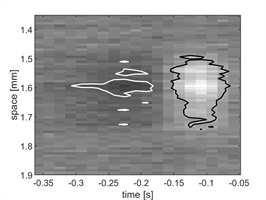Research at our Institute produced a new statistical test that enhances our understanding of how visual neurons in the eye process information. In his recent research, Murat Okatan has focused on a key concept called the spatio-temporal receptive field (STRF), which refers to the specific area of visual space that influences the temporal pattern of activity of a given neuron. By analyzing the relationship between the neuron's activity and the visual stimulus it receives, the underlying mechanisms of visual perception can be unraveled.
This research is an outgrowth of the “Computational Neuroscience” course that Okatan opened in 2019 under the Information and Communications Engineering Doctorate Program.
“The course’s main goal is to bring the students up to speed with contemporary research in spike train analysis; estimating the STRFs of these neurons is the subject of a homework,” said Okatan.
In order to estimate the STRF, researchers commonly use a method called spike-triggered averaging of binary pseudo-random stimulus sequences. This technique involves recording the neuron's activity, known as a spike train, while presenting a series of binary (black and white) patterns as visual stimuli. By averaging the frames of the stimuli that coincide with the neuron's spikes at fixed time intervals, scientists can estimate the neuron's STRF.
However, until now, an exact analytical method to determine the statistical significance of these estimated STRF values was not available. In other words, scientists lacked a way to confidently identify which features of the STRF were statistically significant and to explore how they related to experimental variables. This is where the newly developed statistical significance test comes into play.
The test relies on deriving the distribution of estimated STRF pixel values under the assumption that the occurrence of spikes and the values of the visual stimuli are statistically independent. By understanding this distribution, researchers can calculate amplitude thresholds that allow them to determine which pixels in the STRF represent significant effects, rejecting the null hypothesis of independence. This helps identify the important features of the STRF and provides insights into the neuron's receptive field size.
To showcase the effectiveness of this method, Okatan applied it to spike trains collected from individual mouse retinal ganglion cells, which are responsible for transmitting visual information from the photoreceptors in the retina to the brain. The data were obtained from CRCNS.ORG.
“Databases like CRCNS.ORG are gold mines for Computational Neuroscientists, since they showcase very large amounts of high-quality data collected across many different species and neural subsystems,” Okatan said.
“These data were collected by Lefebvre et al. (2008) in a study that investigated the structure and function of retinal networks in mutant and wild type mice, and were contributed to CRCNS.ORG by Zhang et al. (2014),” Okatan added.
The application of the new test to these data reveals the fine structure of the STRFs. The figure below shows the structure of the STRF of an ON-cell, so-called because the rightmost subfield of the STRF indicates a responsiveness to an increase in light intensity. The contour lines, which were obtained using the newly developed test, enclose pixels that are statistically significant (
P<0.05, two-tailed; Bonferroni corrected; see
paper for details). The findings not only provided valuable insights into how these cells process visual information but also demonstrated the potential of the statistical test for broader applications in the study of visual perception.

Fine structure of the OFF- (left) and ON-subfield (right) of an STRF, revealed by the newly developed statistical significance test. Note the higher level of fragmentation observed in the OFF-subfield. First published in Signal, Image and Video Processing, https://doi.org/10.1007/s11760-023-02603-1, 2023, by Springer Nature.
“We are planning to apply this test to a larger number of cells in the same database to see whether we can pick up new features that can distinguish between the mutants versus the wild type,” said Okatan, “it would be fascinating if the test leads to some new neuroscientific information”.
In conclusion, the development of a statistical significance test for spatio-temporal receptive field estimates is a significant advance in exploring the inner workings of visual neurons and their networks. This research opens up new avenues for investigating visual perception and could contribute to advancements in fields such as neuroscience, psychology, and computer vision.
References
Lefebvre, J. L., Zhang, Y., Meister, M., Wang, X., and Sanes, J. R. (2008) Gamma-Protocadherins regulate neuronal survival but are dispensable for circuit formation in retina. Development. DOI: 10.1242/dev.027912
Okatan, M. (2023) A statistical significance test for spatio-temporal receptive field estimates obtained using spike-triggered averaging of binary pseudo-random sequences. SIViP. https://doi.org/10.1007/s11760-023-02603-1. SharedIt Link: https://rdcu.be/ddhK1
Zhang, Y., Asari, H., Meister, M. (2014) Multi-electrode recordings from retinal ganglion cells. CRCNS.org. https://doi.org/10.6080/K0RF5RZT